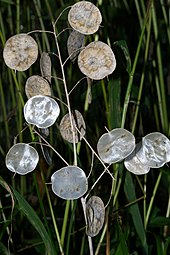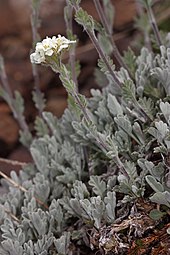Brassicaceae
| Brassicaceae | |
|---|---|

| |
| Winter cress, Barbarea vulgaris | |
| Scientific classification | |
| Kingdom: | Plantae |
| Clade: | Tracheophytes |
| Clade: | Angiosperms |
| Clade: | Eudicots |
| Clade: | Rosids |
| Order: | Brassicales |
| Family: | Brassicaceae Burnett[1] |
| Genera | |
Brassicaceae (
The family contains 372
The family contains the
Pieris rapae and other butterflies of the family Pieridae are some of the best-known pests of Brassicaceae species planted as commercial crops. Trichoplusia ni (cabbage looper) moth is also becoming increasingly problematic for crucifers due to its resistance to commonly used pest control methods.[4] Some rarer Pieris butterflies, such as P. virginiensis, depend upon native mustards for their survival in their native habitats. Some non-native mustards such as Alliaria petiolata (garlic mustard), an extremely invasive species in the United States, can be toxic to their larvae.
Description

Species belonging to the Brassicaceae are mostly
Inflorescence and flower
Ovary, fruit and seed
There is one
Differences with similar families
Brassicaceae have a bisymmetrical corolla (left is mirrored by right, stem-side by out-side, but each quarter is not symmetrical), a septum dividing the fruit, lack stipules and have simple (although sometimes deeply incised) leaves. The sister family Cleomaceae has bilateral symmetrical corollas (left is mirrored by right, but stem-side is different from out-side), stipules and mostly palmately divided leaves, and mostly no septum.[5] Capparaceae generally have a gynophore, sometimes an androgynophore, and a variable number of stamens.[8]
Phytochemistry
Almost all Brassicaceae have C3 carbon fixation. The only exceptions are a few Moricandia species, which have a hybrid system between C3 and C4 carbon fixation, C4 fixation being more efficient in drought, high temperature and low nitrate availability.[9] Brassicaceae contain different cocktails of dozens of glucosinolates. They also contain enzymes called myrosinases, that convert the glucosinolates into isothiocyanates, thiocyanates and nitriles, which are toxic to many organisms, and so help guard against herbivory.[10]
Taxonomy
| core Brassicales |
| |||||||||||||||||||||||||||||||||||||||||||||
Relationships within the family
Early classifications depended on morphological comparison only, but because of extensive
| Brassicaceae |
| |||||||||||||||||||||||||||||||||||||||||||||||||||||||||||||||||||||||||||||||||||||||||||||||||||||||||||||||||||||||||||||||||||||||||||||||||||||||||||||||||||||||||||||||||||||||||||||||||||||||||||||||
Genera
As of October 2023 Plants of the World Online accepts 346 genera.[15]
Etymology
The name Brassicaceae comes to international scientific vocabulary from Neo-Latin, from Brassica, the type genus, + -aceae,[16] a standardized suffix for plant family names in modern taxonomy. The genus name comes from the Classical Latin word brassica, referring to cabbage and other cruciferous vegetables. The alternative older name, Cruciferae, meaning "cross-bearing", describes the four petals of mustard flowers, which resemble a cross. Cruciferae is one of eight plant family names, not derived from a genus name and without the suffix -aceae that are authorized alternative names.[17]
Distribution
Brassicaceae can be found almost on the entire land surface of the planet, but the family is absent from Antarctica, and also absent from some areas in the tropics i.e. northeastern Brazil, the
Ecology
Brassicaceae are almost exclusively
Brassicaceae contain
Since its introduction in the 19th century, Alliaria petiolata has been shown to be extremely successful as an
Invasive aggressive mustard species are known for being self-fertile, seeding very heavily with small seeds that have a lengthy lifespan coupled with a very high rate of viability and germination, and for being completely unpalatable to both herbivores and insects in areas to which they are not native. Garlic mustard is toxic to several rarer North American Pieris species.
Uses


This family includes important agricultural crops, among which many vegetables such as
was used up.
The Brassicaceae also includes ornamentals, such as species of
The small Eurasian weed
Some species are useful as food plants for
Gallery
-
Coast/sand-loving wallflower Erysimum ammophilum
-
Honesty Lunaria annua
-
Western wallflower Erysimum capitatum var. capitatum
References
- hdl:10654/18083.
- ^ Chisholm, Hugh, ed. (1911). . Encyclopædia Britannica. Vol. 7 (11th ed.). Cambridge University Press. p. 521.
- ^ "Brassicaceae". The Plant List.
- ^ Turini TA, Daugovish O, Koike ST, Natwick ET, Ploeg A, Dara SK, Fennimore SA, Joseph S, LeStrange M, Smith R, Subbarao KV, Westerdahl BB. Revised continuously. UC IPM Pest Management Guidelines Cole Crops. UC ANR Publication 3442. Oakland, CA.
- ^ a b c d Al-Shehbaz, I.A. (2012). "Neotropical Brassicaceae". Neotropikey—Interactive key and information resources for flowering plants of the Neotropics. Retrieved 2017-07-12.
- ^ Metcalfe, C.R.; Chalk, L. (1950). Anatomy of Dicotyledons. Vol. 1: Leaves, Stem, and Wood in relation to Taxonomy, with notes on economic Uses. Oxford At The Clarendon Press. pp. 79–87.
- ^ a b c d Renate Schmidt; Ian Bancroft, eds. (2010). Genetics and Genomics of the Brassicaceae. Plant Genetics and Genomics: Crops and Models. Vol. 9. Springer Science & Business Media.
- ^ a b c d e "Brassicaceae: Characters, Distribution and Types (With Diagram)". biologydiscussion. 2016-08-30. Retrieved 12 July 2017.
- ISBN 9789400739123.
- ^ a b Woods, Harry Arthur. Ecological and Environmental Physiology of Insects. Ecological and Environmental Physiology Series. Vol. 3. Oxford biological.
- ^ S2CID 39584525.
- (PDF) from the original on 2017-08-03.
- .
- PMID 24984034.
- ^ Brassicaceae Burnett. Plants of the World Online. Retrieved 16 October 2023.
- ^ Merriam-Webster, Merriam-Webster's Unabridged Dictionary, Merriam-Webster, archived from the original on 2020-05-25, retrieved 2016-07-28.
- ICBN.
- ^ a b "Brassicales". MOBOT. Retrieved 2017-07-18.
- PMID 27092164.
- PMID 21316065.
- ^ Eubanks, HM.D., Hoffmann, J.H., Lewis, E.E., Liu, J., Melnick, R., Michaud, J.P., Ode, P., Pell, J.K., 2017. Biological Control Journal. Elsevier. https://www.journals.elsevier.com/Biological-Control
- ^ Becker, R., Gerber E., Hinz H., Katovich E., Panke B., Reardon R., Renz R., Van Riper L., 2013. Biology and Biological Control of Garlic Mustard. The Forest Technology Enterprise Team. https://www.fs.fed.us/foresthealth/technology/pdfs/FS_garlicmustard.pdf
- ^ UF IFAS, 2017. Biological Control. University of Florida. https://plants.ifas.ufl.edu/manage/control-methods/biological-control/
- ^ a b Driesche, F.V.; Blossey, B.; Hoodle, M.; Lyon, S.; Reardon, R., 2010. Biological Control of Invasive Plants in the Eastern United States. USDA Forest Service. Forest Health Technology Enterprise Team. http://wiki.bugwood.org/Archive:BCIPEUS
- ^ Davis, Adam. 2009. Munching on Garlic Mustard—A New Weevil in the Works. United States Department of Agriculture—AgResearch Magazine. https://agresearchmag.ars.usda.gov/2009/jul/weevil/
- ^ Blossy, B., Ode, P., Pell, J.K., 1999. Development of Biological Control for Garlic Mustard. Cornell University. https://www.dnr.illinois.gov/grants/documents/wpfgrantreports/1998l06w.pdf
- ^ Landis, Doug. "Management Options". Integrated Pest Management. Michigan State University. Retrieved 10 September 2017.
- ^ Reardon, Richard. "FHTET Biological Control Program—Sponsored Projects" (PDF). FHTET Biological Control Program. USDA Forest Service. Archived (PDF) from the original on 2022-10-09. Retrieved 10 September 2017.
- ^ Becker, R. (2017). "Implementing Biological Control of Garlic Mustard—Environment and Natural Resources Trust Fund 2017 RFP" (PDF). Archived (PDF) from the original on 2017-09-04.
- ^ Davis, S., 2015. Evaluating threats to the rare butterfly, Pieris "virginiensis". Wright State University. https://etd.ohiolink.edu/!etd.send_file?accession=wright1431882480&disposition=inline Archived 2017-08-20 at the Wayback Machine
- S2CID 42741171.
- ISBN 978-0715334232.
- (PDF) from the original on 2022-10-09. Retrieved 2017-08-12.
- ^ Hilty, John (2017). "Smooth Rock Cress". Illinois Wildflowers. Dr. John Hilty. Retrieved 17 April 2018.
External links
- BrassiBase, a collection of resources on Brassicaceae biology
Further reading
- Arias, Tatiana; Pires, J. Chris (October 2012). "A fully resolved chloroplast phylogeny of the brassica crops and wild relatives (Brassicaceae: Brassiceae): Novel clades and potential taxonomic implications". Taxon. 61 (5): 980–988. .



